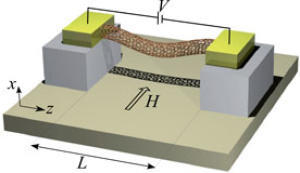What limits the behaviour of a carbon nanotube? This is a question that many scient-ists are trying to answer. Physicists at University of Gothenburg, Sweden, have now shown that electromechanical principles are valid also at the nanometre scale. In this way, the unique properties of carbon nanotubes can be combined with classica-l physics -- and this may prove useful in the quantum computers of the future.
"We have been studying carbon nanotubes theoretically, in order to see how they beh-ave when they are stimulated to behave according to the laws quantum mechanics. The results provide a completely new platform for scientists to stand on," says Gustav Sonne of the Department of Physics at the University of Gothenburg.
Every day we use a number of different microelectromechanical components for variou-s forms of detection, to determine whether a certain process has taken place or whe-ther a certain substance is present. These cannot be detected without instruments. One example is the detection of rapid accelerations that is used to activate the airbag in a car during an accident. What all of these components have in common is that they combine mechanical and electronic properties in order to react to externa-l stimuli.
Gustav Sonne has taken research down to a whole new dimension -- from the micromete-r scale to the nanometer scale -- and he has studied the younger brothers of these components: nanoelectromechanical systems. The studies have been based on tiny nano-tubes suspended between two electrical contacts. He has subsequently calculated how small vibrations in the suspended tubes can be coupled to a current that is led thr-ough them.
"Our research has focussed mainly on how these systems, which consist of a tiny, super-light mechanical oscillator (the suspended nanotube), can be described in qua-ntum mechanical terms, and what effects this has on the measurements we can carry out. We have been able to demonstrate a number of new mechanisms for electromechani-cal coupling that should be possible to observe experimentally. This, in turn, may lead to extremely exotic physical phenomena in these structures, phenomena which may be of interest for research into quantum computers, and other fields."
Interest in nanotubes is based on their outstanding properties: they are among the strongest materials known, weigh next to nothing, and have extremely high conductiv-ity for both electric currents and heat. Carbon nanotubes can be used to manufactur-e composite materials that are several orders of magnitude stronger than currently available materials.
The thesis "Mesoscopic phenomena in the electromechanics of suspended nanowires"was successfully def-ended in the Department of Physics. Supervisor: Associate professor Leonid Gorelik.

A suspended carbon nanotube can be made to vibrate like a guitar string. Gustav Sonne has studied how these oscillations influence the properties of the system if a magnetic field (H) is used to couple the mechanical motion of the tube to the ele-ctric current through it. (Credit: Image courtesy of University of Gothenburg)

